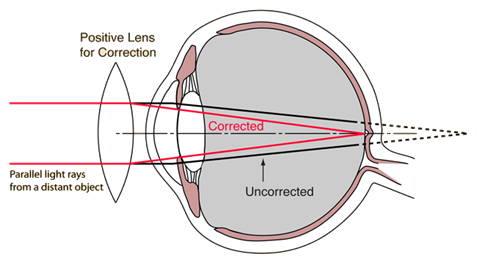A person is unable to see distinctly the words printed on a newspaper. Name the defect of vision he is suffering from. Draw ray diagram to illustrate this defect. List its two possible causes. Draw a ray diagram to show how this defect may be corrected using a lens of appropriate focal length.
The person is suffering from hypermetropia as he is not able to see objects placed closer to the eyes. Hypermetropia or far sightedness is an eye defect in which a person is not able to see things placed closer to the eye. A normal person can see things clearly beyond 25 cm (least distance of distinct vision). If an object is placed between the least distance of distinct vision & the near point (the minimum distance up to which the objects can be seen clearly) then a person suffering from hypermetropia will not be able to see such things. Some of the causes of hypermetropia are:
•Low converging power of eye lens because of weak action of ciliary muscles.
•Abnormal shape of the cornea

In this defect, the light rays coming from the object placed between near point & the point of least distance of distinct vision, after refraction from the eye lens converges to a point beyond the retina. This implies that the image is formed beyond the eye thus creating a blurry image. In such cases the focal length of the eye lens increases. So to bring the image on retina a double convex lens is used. The double convex lens converge the light rays coming from the object in front of the eye lens. In other words, the convex lens creates an image of the object at the near point. Now this image acts as an object for the eye lens and thus forming image on the retina. The focal length of the convex lens should be:
f = ![]()
Where d is the least distance up to which the person is able to see.